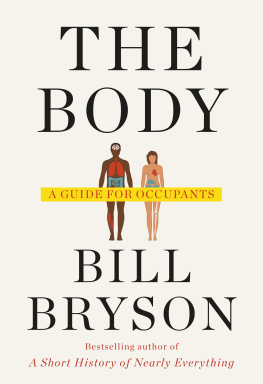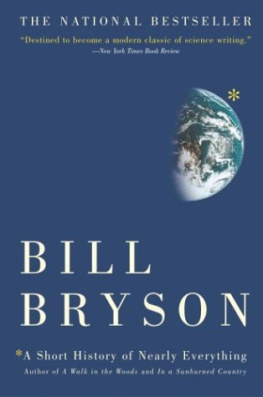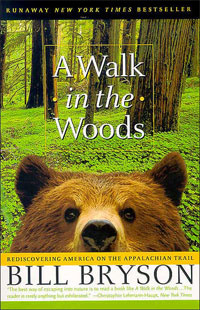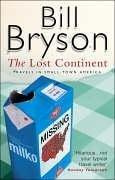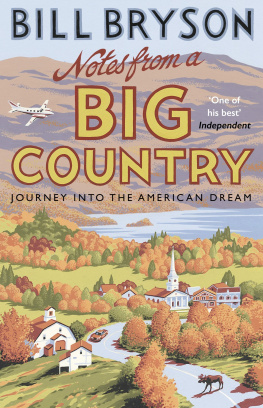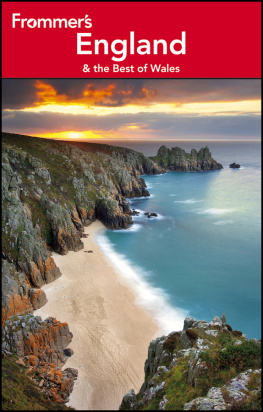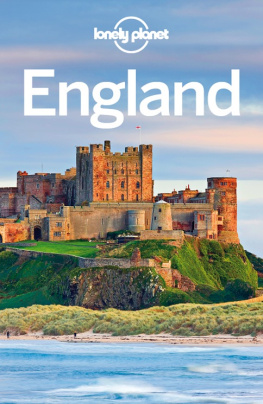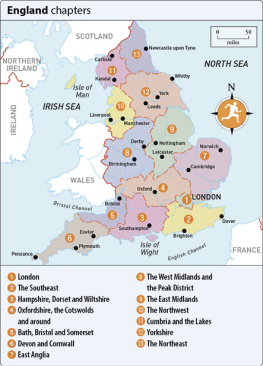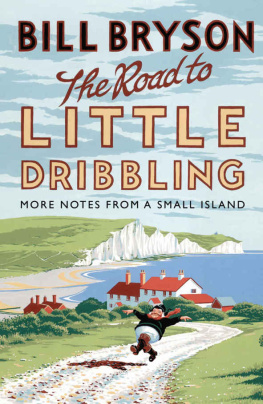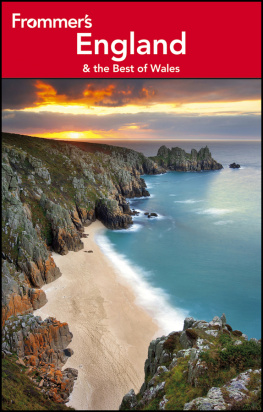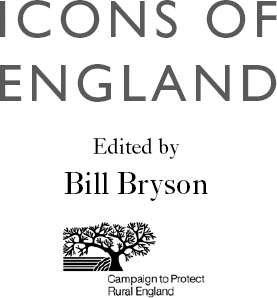About the Book
There are particular places in England that come as close to perfection as youre ever likely to find on this planet.
Bill Bryson
Bill Bryson incited over ninety of our best-loved writers, broadcasters and commentators to pick their icons of England. The resulting celebration of the English countryside is an idiosyncratic and personal collection that ranges across landscape, history, cherished memories and that most English of subjects, the weather.
Contributions from, among others:
Antony Beevor Alan Titchmarsh Sebastian Faulks Michael Palin Andrew Marr Rick Stein Jo Brand Sister Wendy Beckett Jonathan Dimbleby Wendy Cope Joan Bakewell Dick Francis Robert Macfarlane Melvyn Bragg Eric Clapton John Sergeant Kevin Spacey Kate Adie Simon Jenkins Simon Barnes Zac Goldsmith Ronald Blythe Libby Purves
All royalties to CPRE
CONTENTS
THE CAMPAIGN TO PROTECT RURAL ENGLAND
warmly thanks all those who have contributed to this
book. We dedicate it to the many thousands of volunteers
who have worked so hard and given so freely of their
time since we were founded in 1926.
Registered charity no: 1089685
www.cpre.org.uk
FOREWORD
His Royal Highness
The Prince of Wales
CLARENCE HOUSE
There is perhaps a rich irony in the fact that it takes an American, albeit one who has lived in these islands for many years, to recognize, celebrate and fight to preserve so much of what is precious about our country. There can be no-one who more deserves the title of honorary Englishman than Bill Bryson. Through his books, films and his campaigning as President of the Campaign to Protect Rural England he has done so much to help us appreciate the wonders and charms which surround us and to which, too often, we seem utterly blind. We all owe him the greatest possible debt, and so I could not be more pleased to write a foreword to this remarkable book, Icons of England.
And what greater icon could we have than our countryside, which I have always believed helps to define our identity as a nation? England is blessed with some of the most beautiful scenery in the worid. The patchwork quilt of fields, moors, forests, villages, and market towns which spreads across this land is the product of a golden combination of Natures gift to us and the toil and care of generations of farmers and their families who have managed the land. To me, it embodies Englands very soul and is as precious as any Cathedral. The dry stone walls, the hedges, the thatched cottages, the village Churches, pubs, post offices and shops are at the heart of what it means to be English, as are the people whose skills and craftsmanship and commitment keep them alive.
For more than eighty years, the Campaign to Protect Rural England has been leading the fight to preserve the remaining delicate fabric of our countryside. The foresight of the founding fathers was extraordinary in 1926 Clough Williams-Ellis, whom I remember well and admire greatly, published England and the Octopus, an anti-sprawl polemic, and in the same year Sir Patrick Abercrombie wrote his paper, The Preservation of Rural England. The fight has continued since then and great successes have been won. Indeed, the recent creation of the South Downs National Park, sixty years after it was first proposed, shows the importance of perseverance and is a huge cause for optimism. When we do all come together to work towards a goal, so much can be achieved. It gives me hope that we will not allow our traditions and heritage to be swept away, and that we will look once more to the land for nourishment, healing, wisdom and inspiration.
When asked what, for them, encapsulates the English countryside, the contributors to this book came up with a wide variety of personal icons, from a favourite landscape to a treasured monument, from a particular species of wildlife to a familiar rustic emblem or rural tradition. Together they have created an eclectic and richly varied celebration of Englands countryside. I pray that this book will inspire us all to work tirelessly to preserve everything that is best in our magnificent countryside and to ensure that it remains at the very heart of our great island story.
INTRODUCTION
Bill Bryson
President, CPRE
YEARS AGO, WHEN I was brand new to Britain and everything was still a mystery to me, I went with an English friend to Brighton for the day, and there I saw my first seaside pier. The idea of constructing a runway to nowhere was one that would never have occurred to me. I asked her what it was for.
Well, they let you walk out and see the sea, she explained as if I were a little simple.
But we can see the sea from here, I pointed out.
No, you dont understand. You walk out to the end and you are over the sea. Its lovely.
Can you see coral reefs and shipwrecks and things? I asked hopefully.
No, its just murky water.
Can you see France?
Of course not. You just see the sea. Her tone betrayed perhaps just a hint of exasperation. You take the air. Its very bracing.
And then what?
Then you walk back and have some whelks and stroll along the promenade and maybe ride a donkey on the beach no, I dont know why; its just something else we do and then you have an ice cream and get on the train and go home.
And this is a fabulous day out?
Oh yes, its lovely. Especially if it doesnt rain.
I have since come to realize that she was right about everything but the whelks. (If you are reading this in another country and arent familiar with that marine delicacy, you may get the same experience by finding an old golf ball, removing the cover and eating what remains. The only difference is that the golf ball has a little more flavour.) Indeed, after some thirty years of devoted observation, I have come to appreciate that the things that make England what it is which is to say, like nowhere else on Earth and however peculiar they may seem at first blush, are actually quite endearing and often deeply admirable. This is a book about those things.
Four qualities in particular, I think, set English icons apart and make them more memorable, more individual, vastly more noteworthy than icons elsewhere. Foremost among these is the ability so gloriously evinced in the seaside pier to be magnificent while having no evident purpose at all.
Consider one of my own favourite national glories, the wondrously artificial, profoundly inexplicable Silbury Hill in Wiltshire the largest man-made mound in Europe. Built at about the same time as Stonehenge, it covers five acres and rises 130 feet above the surrounding landscape. It is positively immense, and involved an almost unimaginable commitment of labour. Yet Silbury Hill has no known purpose. It is not a burial chamber and holds no treasures. It consists of nothing but soil and rock carefully formed into a large pudding-shaped hill. All that can be said for certain is that some people at some time in the very distant past decided, for purposes we cannot guess, to make a large hill where previously there had been none.
Next page
